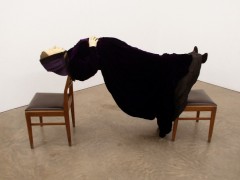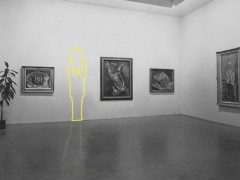Champs élysées
NOUVELLES VAGUES
Palais de Tokyo, Paris
21.06 – 09.09 / 2013
Pursuing their activities alternately in New York, Paris, Milan, Tokyo or Prague, the curators Julie Boukobza, Simon Castets and Nicola Trezzi develop a hybrid activity combining art criticism and curating. Working together here for the first time, they approached their exhibit “Champs Elysées” as a cemetery for works that play on funerary aesthetic and on the persistence of burial rites. Like a cemetery, the exhibition space outlines a new perimeter of investigation, playing on curatorial practices and examining the relationship of art to its eternal partner, death.
In Greek mythology, the abode of the blessed after death. (Webster’s)
In Loss of Breath (1832), Edgar Allan Poe underlines the aesthetic value of tombs with a Freudian slip, confusing the words sepulture and sculpture: “we arrived at the place of sculpture, and I felt myself deposited within the tomb.”
Born out of crumbling religious beliefs and outdated sanitary concerns, the graveyard continues to materialize the memory of the deceased. Surviving the secularization of Western societies, the cemetery remains an intensely invested space, the inexorable destination for eternal sleep, the metatory retreat of the dead, either buried or cremated. Although conceived to receive the dead, the cemetery, a creation by and for the living, is a reflection of its socioeconomic environment with an illusory varnish of eternity.
Through a selection of either specially produced or already existing artworks, “Champs élysées” invites over twenty artists to turn the exhibition space into an ideal cemetery, reexamining the decorative and performative aspects of the funerary within an immersive display. Contemplating the museum as cemetery, the exhibition transports the aesthetic of the cemetery back to the museum. Described by Paul Valéry as a mere amalgamation of “dead visions”2 museums sometimes appear themselves as cemanderies of lifeless ideas. In « Champs Elysées », artistic representations of death and the cemetery call for further explorations of the gallery space as a context designed to testify to the life of cultural production.
“Champs élysées” suggests links between the graveyard’s aesthetic aspects and its societal function, perceiving fertile artistic ground in the persistence of funerary rites. Selected artists do not only present the idyllic necropolis through its static and hackneyed image (tombstones, chrysanthemums, crucifixes, tears, portraits of the deceased, eco-friendly urns etc.) but also as the premise for guided tours, black magic ceremonies, chess tournaments and secret encounters.
Artists
Harold Ancart, Danai Anesiadou, Matteo Callegari, Valentin Carron, Anna Craycroft, Trisha Donnelly, Ida Ekblad, Simone Fattal, Lara Favaretto, Hans-Peter Feldmann, Ian Hamilton Finlay, Susan Hefuna, Tom Holmes, Jamie Isenstein, Esther Kläs, Henri Labrouste, Maria Loboda, Goshka Maçuga, Rodrigo Matheus, Duane Michals, Sarah Ortmeyer, Sarah Pucci, Davis Robbins, Auguste Rodin, Cindy Sherman, Haim Steinbach, Alice Tomaselli.
Practical informations
Palais de Tokyo
13, avenue du Président Wilson,
75 116 Paris
Level 2 – Grande Verrière / Travée
This post is also available in: Spanish


 Home
Home

